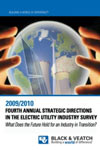
U.S. Electric Utility Survey Reflects Impact of Uncertainty
Reliability of the electric grid, regulatory issues, and long-term investment are the top concerns of U.S. electric power industry leaders, according to Black & Veatch's fourth annual survey.
The "Strategic Directions in the Electric Utility Industry Survey" for 2009/2010 polled 329 industry participants, including professionals from public sector (municipal, state and federally owned) and investor-owned utilities. For more details on the electric utility survey and downloadable visuals, visit www.bv.com/energysurvey.
"The times are tough, so the industry is returning to its job one: maintaining reliable service and preserving financial health. Reliability and regulation popped back to the top of the major issues of concern for industry managers," said William Kemp, who leads Black & Veatch's management consulting services around strategy and sustainability.
Highlights of the survey include:
-
Many utilities' industrial and commercial sales have been severely or seriously eroded by the recession, and less than one-quarter of respondents think electricity usage in their area will grow by more than 1.5 percent annually in the next 10 years. Growth expectations have ratcheted down.
-
Nuclear energy was selected as the generation technology that is best suited to help the country meet environmental standards, followed by wind and natural gas. The rapid rise of natural gas in the rankings – it was deep in the pack in last year's survey – indicates growing confidence in gas as an economically and environmentally attractive bridge to a lower carbon future.
-
Wind power projects are under way or planned within the next 3-to-5 years by nearly 79 percent of survey takers. Solar technology also achieved significant penetration, with 73 percent of respondents reporting projects under way or planned within the 3-to-5 year horizon.
-
Electric utility spending on programs for energy efficiency and demand-side management is surging, to almost 2 percent of revenue. The survey responses indicate that the industry is spending an amount equivalent to about 15-20 percent of its pre-tax earnings – to get customers to use less of its product.
-
Capital spending on new electric infrastructure has declined for two years in a row – for the first time since the 1930s. Generating plants are the asset group in biggest need of replacement. Information technology systems followed close behind, reflecting the priorities placed on the Smart Grid and the need for improved security against cyber attacks that have crippled power grids in other countries.
-
Carbon emissions maintained its place as the dominant environmental concern for electricity industry leaders, with water supply second. However, in a separate question asking survey respondents if they believed there was a future for coal generation, more than 75 percent selected the response: "Yes, when fiscal realities are fully considered."
-
While a majority of respondents expect some form of carbon legislation to be in place by 2012, more than 70 percent do not favor the cap-and-trade system embedded in current legislative proposals. Some 52 percent of the respondents believed that the United States cannot afford carbon legislation.
"Utilities are facing increasing demands to spend more money on basic infrastructure, energy efficiency, the Smart Grid, and cyber security. Their expected leading role in curbing carbon emissions would hit utility costs very hard. Yet their sales are declining or relatively flat, and regulatory commissions are reluctant to approve rate increases when the economy is down. Electric utilities will be hard pressed to satisfy both customers and investors over the next few years," said Kemp.